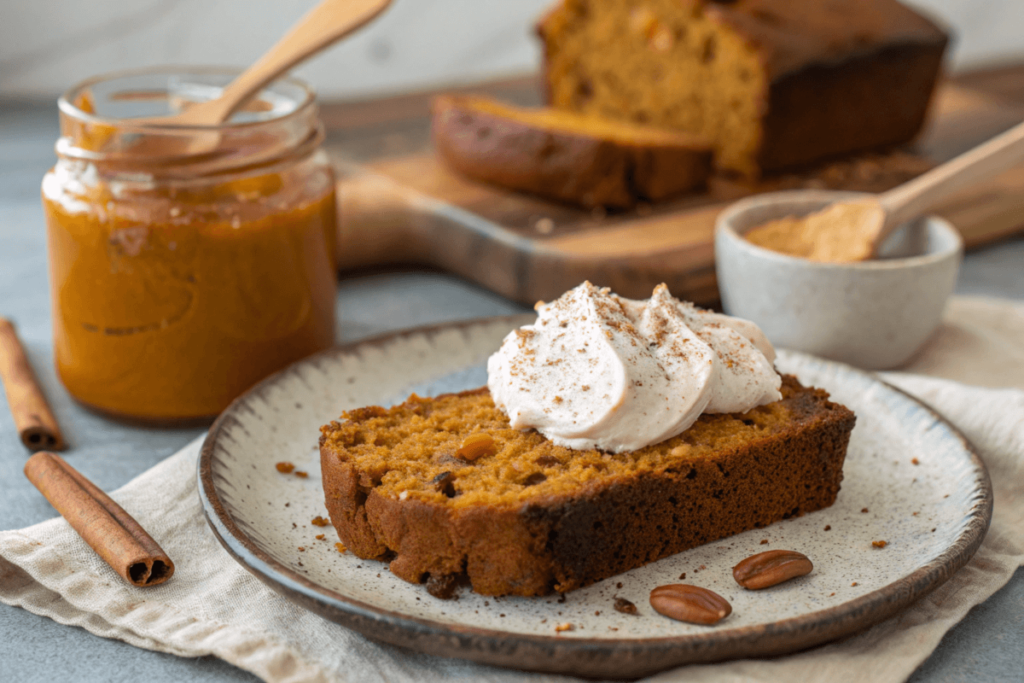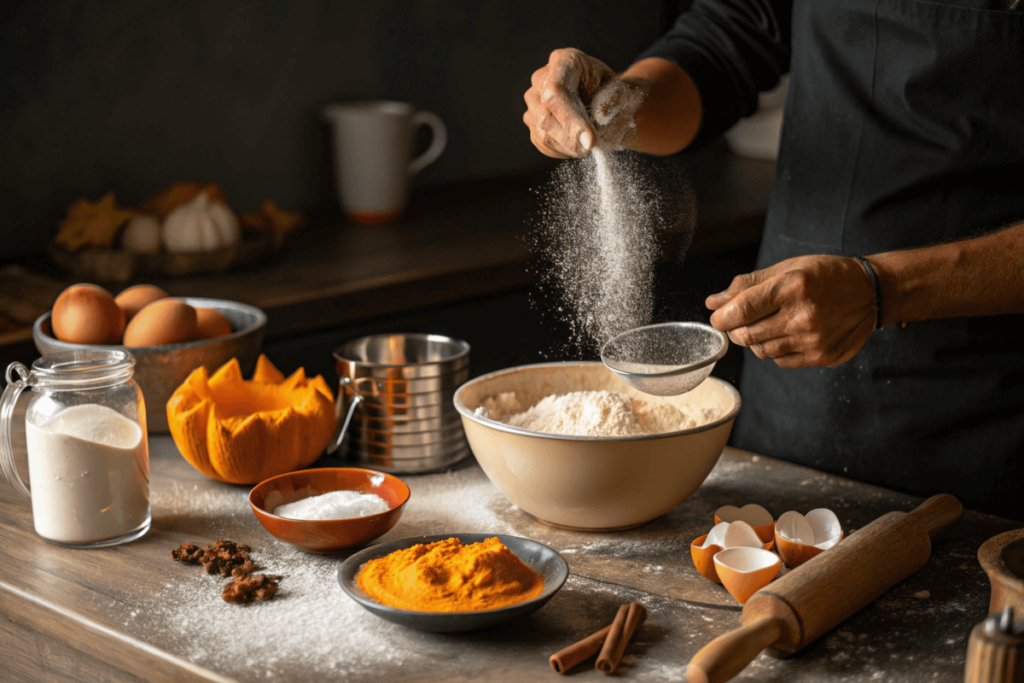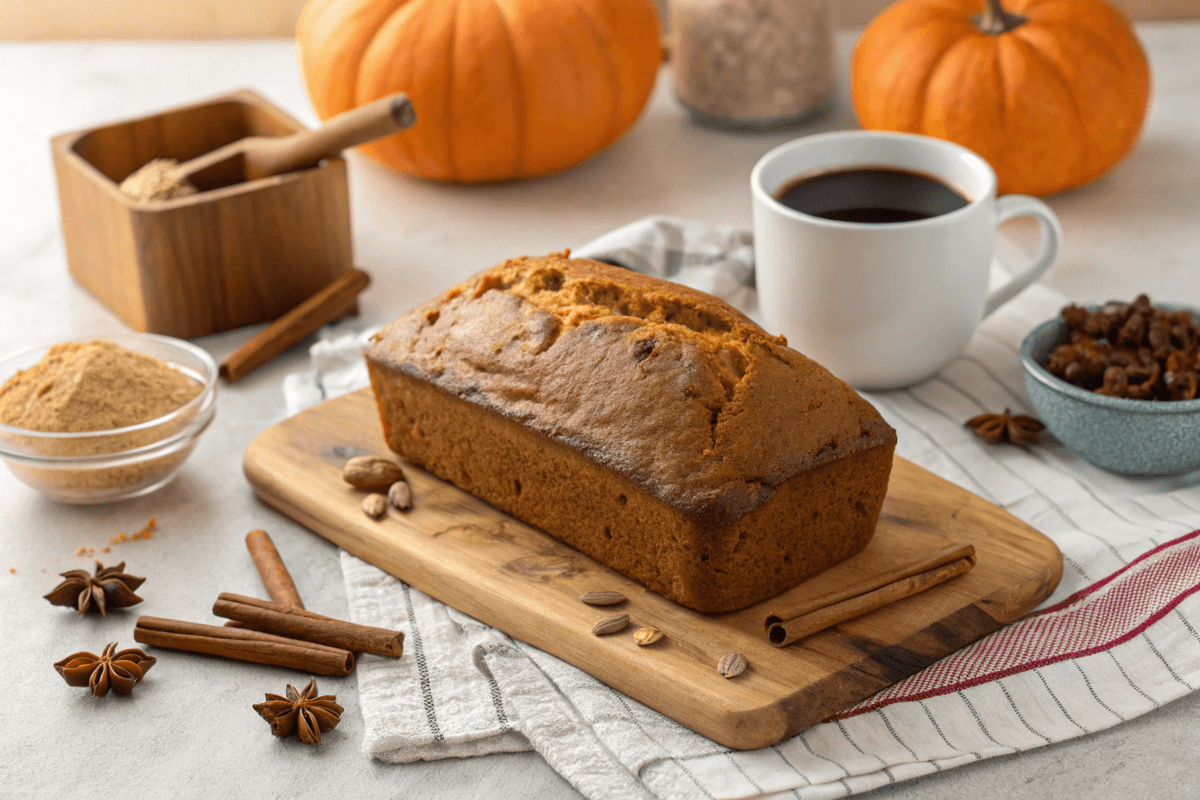Why Does My Pumpkin Bread Have No Flavor?
Pumpkin bread is a beloved fall treat, but what happens when it falls flat in flavor? In this article, we’ll dive into the reasons behind bland pumpkin bread and explore ways to fix it. From understanding the role of key ingredients to learning how to enhance flavor, you’ll walk away with tips that’ll take your pumpkin bread from boring to bursting with taste. Let’s get started!
Understanding the Basics of Pumpkin Bread
What Is Pumpkin Bread?
Pumpkin bread is a type of quick bread that uses baking powder or baking soda as leavening agents instead of yeast. Unlike regular bread, it’s sweet and cake-like, often served as a dessert or snack. The star ingredient, pumpkin, adds moisture, a hint of natural sweetness, and a warm, earthy flavor.
However, the pumpkin itself doesn’t contribute much flavor. That’s why spices and sweeteners are critical in making pumpkin bread taste as good as it smells.
Common Ingredients in Pumpkin Bread
The classic recipe for pumpkin bread includes flour, sugar, eggs, pumpkin puree, baking powder, and a medley of spices like cinnamon, nutmeg, and cloves. Some recipes also call for vanilla extract, brown sugar, or even applesauce to enhance the bread’s texture and flavor.
It’s a simple recipe, but each ingredient plays a specific role. For instance, pumpkin puree provides moisture, while spices deliver the characteristic autumnal aroma. Even a small pinch of salt can make a world of difference by enhancing the sweetness and balancing the overall taste.
The Role of Pumpkin in Flavoring Bread
Here’s a surprising fact: raw pumpkin has a pretty mild flavor! The distinct taste we associate with pumpkin bread largely comes from the spices and sweeteners added to the recipe. Pureed pumpkin does contribute a subtle earthiness, but it’s more about texture than taste.
This explains why some pumpkin breads end up tasting bland—it’s not the pumpkin’s fault! Without enough spices or high-quality pumpkin puree, the bread can lack the bold, comforting flavors we crave. That’s why understanding the basics of ingredient balance is key to achieving the perfect loaf.
Reasons for Lack of Flavor in Pumpkin Bread
Insufficient Sweeteners or Spices
One of the top reasons pumpkin bread lacks flavor is insufficient sweeteners or spices. Many recipes use only a small amount of pumpkin pie spice, leaving the bread tasting bland. Without bold spices like cinnamon, nutmeg, or cloves, the bread misses its characteristic warmth and depth. Similarly, cutting back on sugar to make the bread “healthier” can rob it of the sweetness that balances the earthy pumpkin.
For a more flavorful loaf, don’t skimp on the spices. A blend of brown sugar and white sugar can also enhance sweetness while adding a hint of caramel flavor.

Using Low-Quality Ingredients
The quality of your ingredients makes a huge difference in flavor. Low-quality or expired pumpkin puree can result in a lackluster taste. Similarly, using imitation vanilla extract instead of pure vanilla can affect the bread’s richness.
To improve flavor, opt for high-quality canned pumpkin or make your own puree. Always check the freshness of your spices and invest in real vanilla extract—it’s worth it!
The Impact of Overmixing the Batter
Did you know overmixing the batter can affect your bread’s flavor? Overmixing activates gluten, which can lead to a dense and chewy texture, making it harder for the flavors to shine. Additionally, overworked batter can result in uneven spice distribution, giving some bites more flavor than others.
To avoid this, mix just until the ingredients are combined. A light hand ensures a tender loaf and even flavor throughout.
Effect of Incorrect Baking Temperature and Time
Baking your pumpkin bread at the wrong temperature can also mute its flavor. Too high a temperature might cause the outer layer to cook too quickly, leaving the inside underdone. Too low, and your bread might dry out, dulling its taste.
Always preheat your oven and use a thermometer to ensure accuracy. Baking the bread evenly helps retain the natural sweetness of the pumpkin while allowing spices to infuse properly.
For more tips on baking flavorful pumpkin treats, check out this Pumpkin Banana Loaf recipe for inspiration.
Enhancing Pumpkin Bread Flavor Through Ingredient Adjustments
Adding Spices: Cinnamon, Nutmeg, and Clove
Spices are the backbone of flavorful pumpkin bread. Boost your spice game by increasing the amount of cinnamon, nutmeg, and clove. You can even experiment with cardamom or allspice for a unique twist. Pre-toasting your spices before adding them to the batter intensifies their aroma and taste.
Don’t be afraid to double the spice quantities in your recipe for a bold, flavorful loaf. Remember, these spices are the essence of that cozy, fall-inspired flavor we all love.
Importance of High-Quality Pumpkin Puree
The type of pumpkin puree you use matters. Fresh, homemade puree tends to have a richer flavor and creamier texture than its canned counterpart. However, if you’re short on time, opt for a trusted brand of canned puree labeled 100% pumpkin. Avoid pumpkin pie filling, as it contains added sugar and spices, which might alter your recipe’s balance.
Boosting Flavor with Vanilla Extract
Vanilla extract is a simple yet powerful addition. High-quality, pure vanilla enhances the sweetness and complements the spices, creating a more balanced flavor profile. If you want to elevate your bread further, try using vanilla bean paste for a more intense vanilla experience.
Using Brown Sugar for Depth
Brown sugar isn’t just for cookies! It adds depth and a subtle molasses flavor that pairs perfectly with pumpkin. Replacing half of the white sugar in your recipe with brown sugar can instantly enhance the taste of your bread, giving it a warm, caramel-like note.
Improving Flavor Through Techniques and Baking Tips
Pre-Toasting Spices for Intensity
To amplify the flavor in your pumpkin bread, try pre-toasting your spices. Heating spices like cinnamon, nutmeg, and clove in a dry pan for a few minutes can release their essential oils, making them more aromatic and flavorful. This simple technique ensures your bread will have a rich and warming flavor profile.
Be careful not to burn the spices—toast them over low heat and keep stirring. Once you smell their delicious aroma, they’re ready to add to your batter.
Balancing Wet and Dry Ingredients

The balance between wet and dry ingredients is crucial for a flavorful and moist pumpkin bread. Too much flour can result in a dense, dry loaf, while excess liquid might leave your bread gummy.
Measure your ingredients carefully, using a kitchen scale if possible. A balanced batter allows the flavors of the pumpkin and spices to shine while ensuring the bread has the perfect texture.
Baking at the Right Temperature
Proper baking temperature plays a huge role in the final flavor of your pumpkin bread. If the oven’s too hot, the crust may form too quickly, trapping moisture inside and preventing the spices from fully developing. Conversely, a low temperature can make the bread overly dry and dull.
Always preheat your oven to the recommended temperature, and use an oven thermometer for accuracy. This ensures your bread bakes evenly and comes out with a golden-brown crust and a soft, flavorful interior.
Testing for Doneness: A Critical Step
Underbaked bread not only ruins the texture but also impacts flavor. Insert a toothpick into the center of the loaf—if it comes out clean or with a few moist crumbs, your bread is done. Overbaking, on the other hand, can make the bread dry and rob it of its fresh-baked taste.
For a more detailed guide on perfecting quick breads, check out our Pumpkin Sourdough Bread Recipe.
FAQs
Why Is My Pumpkin Bread Dense Instead of Fluffy?
A dense pumpkin bread often results from overmixing the batter or using too much flour. To fix this, mix just until the ingredients are combined. Additionally, check your leavening agents—expired baking powder or soda won’t give your bread the lift it needs.
How Do I Store Pumpkin Bread to Retain Flavor?
Proper storage is essential to preserve the flavor and texture of pumpkin bread. Wrap it tightly in plastic wrap or store it in an airtight container at room temperature for up to three days. For longer storage, freeze the loaf and thaw it at room temperature when ready to eat.
Can I Use Fresh Pumpkin Instead of Canned?
Yes, but fresh pumpkin puree has a milder flavor than canned. To enhance its taste, roast the pumpkin before pureeing it. This caramelizes its natural sugars, adding depth and sweetness to your bread.
What’s the Best Way to Reheat Pumpkin Bread?
To enjoy warm, flavorful pumpkin bread, reheat individual slices in the microwave for 10-15 seconds. For a crispier texture, toast slices in the oven for a few minutes. Reheating restores the bread’s softness and revives its rich, spiced aroma.
For more delicious recipes, check out our Chocolate Chip Pumpkin Bread for a delightful twist on the classic loaf!
Exploring Common Mistakes in Pumpkin Bread Baking
Overlooking Key Ingredients
One of the most common reasons people ask, Why does my pumpkin bread have no flavor? is because they skip or skimp on essential ingredients. Leaving out salt, for example, might seem harmless, but it plays a critical role in enhancing sweetness and bringing out the flavors of the spices and pumpkin. Similarly, using too little sugar or the wrong type of oil can result in a flat, uninspiring loaf.
To avoid this, follow the recipe closely and use high-quality ingredients. Even a pinch of salt or a drizzle of good olive oil can make a noticeable difference in flavor.
Rushing Through the Process
Baking requires patience, and rushing can lead to mistakes that affect the flavor. For instance, failing to allow your ingredients to come to room temperature can cause uneven mixing, which impacts the texture and taste. Additionally, skipping steps like sifting dry ingredients or not properly creaming butter and sugar can affect how well the flavors blend.
Take your time to measure and prepare each ingredient carefully. Following each step ensures your pumpkin bread has the best possible flavor and texture.
Creative Variations to Boost Flavor
Adding Mix-Ins for Texture and Taste
If your pumpkin bread still feels like it’s missing something, try adding mix-ins like chocolate chips, walnuts, or dried cranberries. These additions can enhance both the texture and flavor, providing a delightful contrast to the soft, spiced bread. Chocolate chips, for example, add sweetness, while nuts offer a satisfying crunch.
You can also experiment with shredded coconut, orange zest, or even a cream cheese swirl for a more indulgent take on the classic loaf. These small changes can transform a bland loaf into a show-stopping treat.
Experimenting with Alternative Sweeteners
For a unique twist, swap out some or all of the sugar with alternative sweeteners like maple syrup, honey, or molasses. Each sweetener brings its own distinct flavor—maple syrup adds a cozy, caramel-like taste, while molasses gives a rich, slightly smoky depth.
These sweeteners pair beautifully with the spices in pumpkin bread, creating a more complex and memorable flavor. Plus, they help keep the bread moist and tender.
With these tips and creative ideas, you’ll never have to wonder Why does my pumpkin bread have no flavor? again. Let me know if you need further sections or refinements!
The Science Behind Pumpkin Bread Flavor
How Ingredients Interact to Create Flavor
The delicious flavor of pumpkin bread comes from a combination of chemical reactions and the blending of complementary ingredients. Spices like cinnamon, nutmeg, and cloves release aromatic compounds during baking, which create the signature warm, cozy scent. At the same time, the sugar caramelizes, giving the bread its slight toasty sweetness, while the pumpkin’s natural sugars add a subtle earthy undertone.
However, if the balance between these components is off, the bread can end up tasting bland. For example, too much flour can overshadow the spices, while insufficient sugar reduces caramelization, leading bakers to ask, Why does my pumpkin bread have no flavor? Understanding how these ingredients work together helps you troubleshoot and refine your recipe.
The Role of Temperature in Flavor Development
Temperature plays a crucial role in enhancing the flavor of your pumpkin bread. During baking, heat activates the leavening agents, causing the bread to rise while also allowing the spices and sugars to meld together. If the oven temperature is too low, these processes won’t happen efficiently, and the bread may taste underwhelming.
To ensure full flavor development, bake at the recommended temperature and avoid opening the oven door too often, as this can lower the heat and disrupt the baking process. Consistent heat is key to creating a flavorful, aromatic loaf.
Troubleshooting Bland Pumpkin Bread
Identifying What Went Wrong
If you find yourself asking, Why does my pumpkin bread have no flavor? it’s time to troubleshoot. Start by evaluating your ingredients—were they fresh and high quality? Spices lose their potency over time, and old flour can result in a dull-tasting loaf.
Next, consider your measurements. Using too much flour or skimping on sugar can throw off the flavor balance. Also, check if you might have accidentally left out key components like salt or vanilla extract, which are small but mighty when it comes to boosting taste.
Adjusting Your Recipe for Better Results
Once you’ve pinpointed the problem, make adjustments. If your spices seem muted, increase the amounts slightly or try adding a pinch of black pepper for extra warmth. For a richer flavor, consider swapping white sugar for brown or adding a tablespoon of molasses.
If texture is the issue, ensure you’re not overmixing the batter, as this can make the bread dense and less enjoyable. By fine-tuning these details, you’ll be well on your way to baking a loaf that’s flavorful and satisfying.
For more tips on baking success, explore our Pumpkin Banana Loaf recipe. Let me know if you need further refinements or additional sections!

